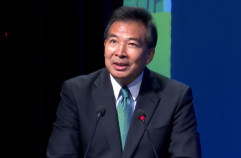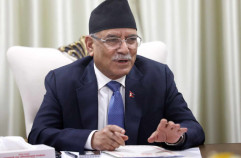The support price of chaite paddy was fixed for the first time
We use Google Cloud Translation Services. Google requires we provide the following disclaimer relating to use of this service:
This service may contain translations powered by Google. Google disclaims all warranties related to the translations, expressed or implied, including any warranties of accuracy, reliability, and any implied warranties of merchantability, fitness for a particular purpose, and noninfringement.

The government has set the minimum support price for Chaite paddy for the first time while the planting of chaite paddy is going on all over the country. The cabinet meeting on Thursday fixed the support price of chaite paddy with 18 percent moisture for the fiscal year 2080/81 at 2,777 rupees and 28 paise per quintal.


In the case of chaite paddy with more than 18 percent moisture, it has been decided to maintain the price based on the weight loss at the rate of 1200 grams per quintal for 1 percent moisture.
The price should be fixed 3 months before planting the crop. Based on that, the farmer decides to plant/not to plant the crop. But this year, the price has been fixed as the paddy planting season is going on. However, experts say that since the price has been fixed for the first time, it is good for the farmers. "The price should be fixed 3 months in advance, even though it is late, the price of Chaite rice has been fixed for the first time," said Uddhav Adhikari, founder president of the Federation of Nepalese Farmers, "It is the first practice and should be welcomed." The official said that the government should pay attention to that as it will be difficult to import crops.
The government should not only set the price, but also find a solution to the problems that arise when the crops are imported. It is necessary to develop a system to reach farmers' fields and buy paddy,'' said the official, 'If the government can reach farmers' fields, rice production will increase.' He said that it took some time to complete all the procedures. "It took about 2 months to get a decision from the Ministry of Industry, Commerce and Supply and the Council of Ministers through the Ministry of Agriculture," he said.
For the minimum price, the price has been fixed by keeping the production cost of the farmer, the Prime Minister's Agriculture Modernization Project, the data of the province and municipality, the transportation to the mill and some percentage of profit. Apart from this, the border price was also taken, said KC. "Support price is minimum price, farmers can sell more," he said. There is no loss to farmers when there is a support price.
In Nepal, rice is cultivated from 60 meters above sea level in Terai to 3050 meters in Chumchaur, the highest place in the world. Agriculture contributes about 24.1 percent to the country's gross domestic product. Rice contributes 15 percent to the domestic production of the agricultural sector. According to the Department of Agriculture, it has significant importance in food and nutrition security. Rice has also played an important role in making the national economy viable. Recently, the area of paddy planting has decreased. The area of both Chaite and Barkhe crops has decreased. The Ministry of Agriculture and Livestock Development has said that the area has decreased due to urbanization and barrenness.
According to the details of the Ministry, compared to 079/80, in 080/81, the area of paddy has decreased by 3,895 hectares. In 079/80, 1 lakh 8 thousand 6 hundred 7 hectares of Chaite rice was planted, in 080/81 it was planted in 1 lakh 4 thousand 7 hundred 12 hectares. Chaite rice production has also decreased by 19 thousand 523 tons. In 079/80, 540 thousand 331 tons of chait paddy was produced, but in 080/81, 520 thousand 888 tons of chait rice were produced. There has also been a decrease in the productivity of rice.
It has come down to 4.97 tonnes per hectare in 080/81 from 4.98 tonnes per hectare last year. Compared to Chaite and Barkhe paddy, the productivity of Chaite paddy is higher. According to the ministry, the productivity of dry paddy is only 3.90 tons. Officials of the Department of Agriculture say that if the production of chaite crop can be increased, the import can be reduced. "Due to heat and light, the productivity of Chaite rice is higher," KC said.
Food could not buy rice
As in previous years, this year too, food and business companies could not buy rice. The company had set a target of purchasing five lakh quintals of paddy in the current financial year. But only 46 thousand 649 quintals have been bought. The company, which has always been accused of delaying the purchase of rice from farmers, started the purchase process in November this time.
The government had fixed the minimum support price of Barkhe paddy for the financial year 080/81 in the last week of October. The minimum support price of coarse paddy was set at Rs 3,198 per quintal and medium paddy at Rs 3,362 per quintal. After that, the rice procurement process was started and food could not meet the target this time as well. After not being able to purchase paddy, food has started the process of buying rice.
प्रकाशित : चैत्र १६, २०८० ०७:३१
 १८.१२°C काठमाडौं
१८.१२°C काठमाडौं














